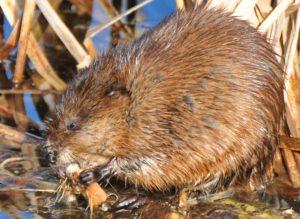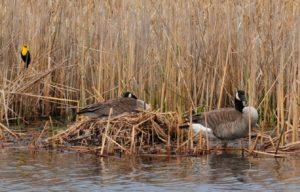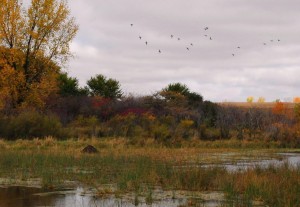Photography courtesy of Lowell Washburn, all rights reserved.
Overcast skies, chill winter wind, rural landscapes cloaked in nine inches of new snow. Absolute perfect conditions for an end of December goose hunt. But for hunting companion Curt Stille and I, the anticipated slam dunk outing was rapidly turning into the proverbial wild goose chase.
The dilemma wasn’t for a lack of birds. There were plenty of Canada geese on the wing. The problem was that the birds could care less about joining the decoys. As line after line of honkers disappeared on the southern horizon we were beginning to get the message. The regal birds had had enough of snow and ice. They were packing it in; heading south toward easier pickings. Happily, there had been one notable exception when a single goose suddenly peeled away from a passing flock and nosily sailed all the way down to our spread. As the plump bird prepared for a landing, Stille rose, shouldered his gun, and sent the honker tumbling to the fresh powder. No surprise. That’s almost always what happens when Curt points a shotgun at a flying bird. What we did not suspect, however, was that it was to be the final shot of the 2015 waterfowl season.
Our assumption that passing flocks were leaving town proved painfully accurate. And although we expected losses to be significant, we were amazed to learn the following morning that ALL the geese had migrated. The open water air hole that had supported several hundred birds twenty-four hours earlier was now completely void of fowl and as iced over as the rest of the lake.
The southward migration of Canada geese is far from unique. Most Iowa birds leave the state during winter. For those wildlife species opting to stay at home and tough it out, winter is a time of hardship and attrition – a life or death, day to day quest for food and shelter. There are a few classic exceptions to the rule, and the muskrat may be our finest example.
Unlike most wildlife species, muskrats began preparing for winter well in advance of the season. Committing their unique work ethic and sharp incisors to the task, muskrats play the role of aquatic lumberjacks, felling cattail stalks at a rate that would make Paul Bunyan sit back and take notice. Muskrats have adopted a communal approach to life, with several individuals working toward a common goal. Once the fall work commences, Iowa wetlands soon become dotted with the familiar dome shaped condos where colonies will spend the winter. As days become shorter, muskrats embrace the task with increased vigor, creating ever larger openings within dense stands of cattail. As lodges begin to take shape, muskrats add additional food and insulation in the form of arrowhead, bulrush, and a wide variety of aquatic roots and tubers. Each completed structure contains a single room located just above the water’s surface. Never knowing how long or harsh the winter will be, muskrats continue construction until cold weather arrives and marshes begin to ice over. By the time winter arrives, building activities have ceased as muskrats retire to the lodge’s interior where they will enjoy the fruits of their labor – literally beginning a process of eating themselves out of house and home. When preparations have been sufficient, food supplies will outlast the winter weather. Come spring, muskrat lodges represent a favored nesting spot for giant Canada geese.
Acre for acre, square foot for square foot, native wetlands represent Iowa’s richest ecosystem. No habitat supports a greater abundance or broader diversity of life. From trumpeter swans to painted turtles to dragonflies, hundreds of plant and wildlife species depend on Iowa wetlands for survival. And of all these life forms, no single species has a greater impact than the lowly muskrat. The muskrat is the marsh’s best friend; and is also its worst enemy.
Following extended periods of low or no water, wetlands become completely choked with vegetation such as cattail. It is an undesirable condition that favors few species. In time, a handful of pioneering muskrats will return to the repopulate the marsh. As new colonies begin to harvest cattails and other aquatic plant life, areas of open water soon appear. The ratio of vegetation to open water eventually approaches 50/50 – a condition known to science as ‘hemi-marsh’; a balance that produces maximum wildlife diversity and abundance. Times are good. But as exploding populations of foraging ‘rats take the cycle to its inevitable ‘open water’ stage, the pendulum swings. As the vegetation needed for food and nesting disappears, wildlife declines to its lowest level. The scarcity will continue until the next drought triggers a cycle of renewal.
Muskrats are a valuable native furbearer. Their high quality pelts are beautiful, rich and durable. From farm boy to furbearer professional, muskrat trapping historically enjoyed recreational and economic importance in Iowa. Although I no longer trap, mink and muskrats were easily my favorites when I did. During the 1970s and 1980s, trapping partner Ed Kotz and I pursued muskrats on several North Iowa wetlands, running our lines morning and night from small “pumpkin seed” boats that we navigated through the cattails. During cycles of abundance, success could be excellent. On one memorable occasion, we took 135 muskrats in one day from a single wetland near Fertile. We didn’t have time to skin and stretch our catch; just sold them as they were and went back to the marsh for more. Prices were also at high cycle; with good unskinned muskrats bringing $8.87 – the 2015 equivalent of $27.15. Nearly four decades later, top carcass ‘rats barely fetch $2.00. The Iowa pelts are as luxurious as ever; the sad fact of the matter is that these days, most young people appear more interested in cell phones, IPads and Facebook than in running traplines or doing anything else in the great out-of-doors. Fortunately, there are still enough young trappers out there to carry on the tradition.






 Susan Judkins Josten
Susan Judkins Josten Rudi Roeslein
Rudi Roeslein Elyssa McFarland
Elyssa McFarland Mark Langgin
Mark Langgin Adam Janke
Adam Janke Joe Henry
Joe Henry Sue Wilkinson
Sue Wilkinson Tom Cope
Tom Cope Kristin Ashenbrenner
Kristin Ashenbrenner Joe Wilkinson
Joe Wilkinson Dr. Tammy Mildenstein
Dr. Tammy Mildenstein Sean McMahon
Sean McMahon